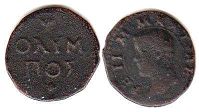Coins of Mantua - catalog with values
Margravate of Mantua (1433–1530)
Lira=20 soldi; Soldo=12 denari
Federico II Gonzaga (1519-1530)

quatrino (4 denari) no date
billon
OΛYMPOΣ
FE II M MANTIAE
Coin value ~ 30-40 USD
Coins of other Italian States
Costs of Mantua coins in this catalog approximate and indicated specifically for the coin shown in the picture.
I do not buy or sell coins - this is just a catalog.

